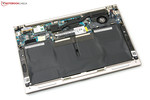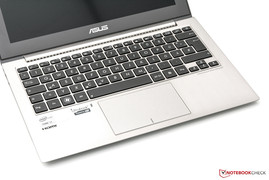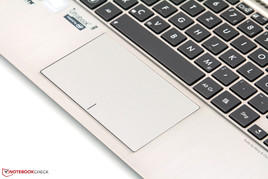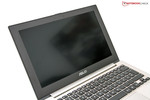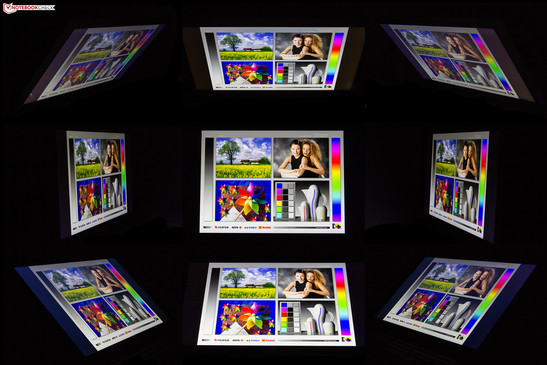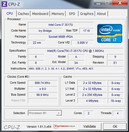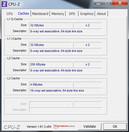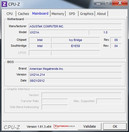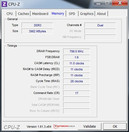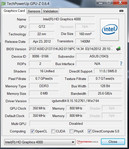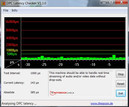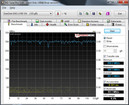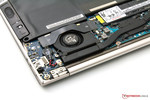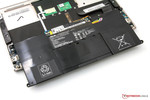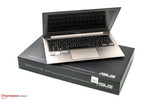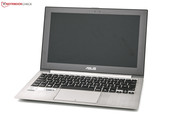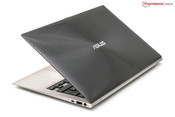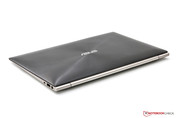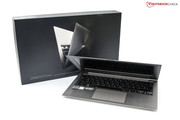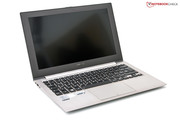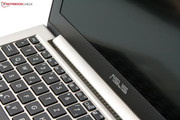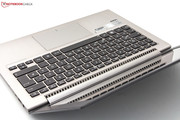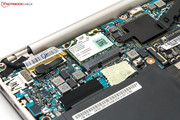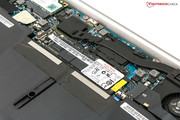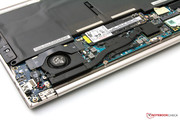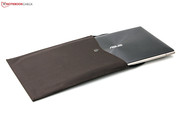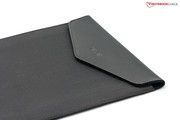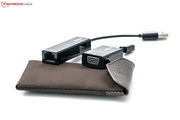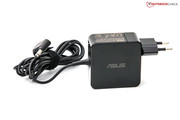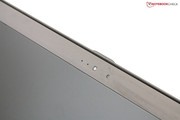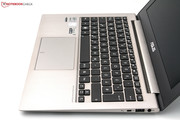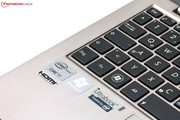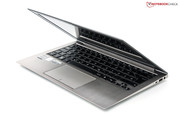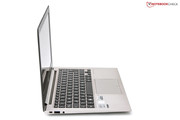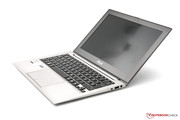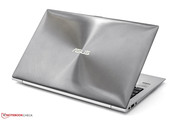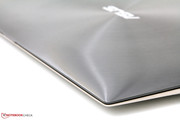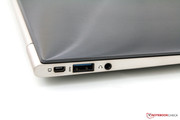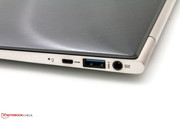Review Asus Zenbook Prime UX21A Ultrabook

With the Zenbook Prime UX21A Ultrabook, Taiwanese manufacturer Asus ushers in the second generation of the smallest member of its Prime series. The familiar aluminum unibody design now houses new and updated components. For a detailed review of the chassis, please take a look at the identically constructed Asus Zenbook UX21E. Our review model features a fast Intel Core i7-3517U dual-core processor with an integrated GMA HD 4000 GPU, a 128 GB SSD, 4 GB DDR3 RAM and updated wireless components. The most standout feature though is the non-glare 11.6-inch IPS based panel, which sports a resolution of 1920x1080 pixels (Full HD, 1080p). No other notebook in this size compares.
The silver design and slim build are a carry-over from the previous generation. What has changed is the keyboard: aside from a chiclet-type layout, the keyboard now features a backlight (three brightness levels). All these changes should allow the UX21A to score very well. In our review we will determine how the UX21A-K1010V stacks up against similarly equipped notebooks, how it compares to its (well received) bigger brother Asus Zenbook Prime UX31A, and if the price of 1199 Euros (MSRP / ~$1550) is justified or not.
Connectivity
The sides of the Ultrabook and the port selection haven't changed much. We appreciate the fact that there are now two USB 3.0 ports - the predecessor only came with one USB 3.0 and one USB 2.0 port. External monitors require the use of an adapter. The Mini VGA adapter is included; the Micro HDMI can be purchased as an add-on. The (familiar) USB 3.0-to-Ethernet adapter is included, however.
All in all not a lot of surprises. The inclusion of a card reader would certainly have been a welcome feature. We would also like to see one more USB port - as it is; the user probably has to resort to a USB hub.
Communication
The wireless communication modules have been updated. WLAN 802.11 a/b/g/n as well as Bluetooth 4.0 are now both handled by an Intel Centrino Advanced-N 6235 wireless card, so the module count (compared to the predecessor) has gone down by one. For wired connections, Asus still relies on the USB dongle, which allows speeds of 10/100 Mbit/s. It appears that the low height prevents an internal solution. The Acer Aspire V5-171-53314G50ass is thicker by about 1 centimeter (0.39 inches) and features a Gigabit Ethernet RJ45 port. Our review system is comparable to the Apple MacBook Air 11 Mid 2012 in that aspect, however.
Accessories
No changes here: aside from the Zenbook itself, the box includes a sleeve for the notebook, the dongles (and a little pouch to carry them in), various pamphlets and documentation, the 45 Watt power adapter (with a 2.5 meter / 8.2 foot cable and EU plug) and a Velcro strap. A dongle adapter for the Micro HDMI is not included; neither are system recovery / restore disks. Asus uses a hidden partition on the SSD for that purpose. The software included meets expectations: programs from Asus, Intel, and Microsoft, a few games, and an Anti-Virus trial software (which we would uninstall because of the annoying pop-ups).
Maintenance
The bottom plate of the UX21A also provides access for maintenance and expansion purposes. Its removal requires the usage of a Torx T5 screwdriver. The fan can be removed and cleaned fairly easily (of course Notebookcheck will assume no liability). The system RAM is soldered onto the motherboard and can't be expanded. The SanDisk SSD is located on a special circuit board, so exchanges are going to be pricey - asusparts.eu charges 385 Euros (~$495) for the 256 GB SSD. The battery is attached with screws and not glued in, so it should be a bit easier to replace - although this task should only be attempted by qualified personnel. Asus charges 80 Euros (~$103) for the lithium polymer battery - plus 75 Euros / ~$97 for the install, if the notebook is outside the warranty period.
Warranty
The UX21A carries a 24-month warranty with pick-up & return service - better than average since the user won't be responsible for shipping costs. Extensions to 36 months total are available for about 90 Euros (~$116).
Input Devices
Keyboard
Opening the Ultrabook reveals a revamped keyboard in the same style as found on the Asus Zenbook Prime UX31A and the UX32VD. Since the chassis of the UX21A is not as large, the borders on the left and right of the keyboard are smaller but the layout is identical. Most of the black keys measure 15 x 13 millimeter (0.59 x 0.51 inches); the right shift key is quite large. Key travel is short - combined with the smaller key size, typing takes some time getting used to. Overall impressions are favorable, however. An advantage of the new design is the backlight, which features 3 brightness settings (for a comparison, see below).
Touchpad
The touchpad has not seen any changes. Asus still uses an Elan SmartPad, which measures 105 x 63 millimeter (4.13 x 2.48 inches) and features integrated mouse buttons. Aside from various multi-touch gestures, the "ClickPad" supports a left mouse click on the entire surface - similar to the touchpad on Apple notebooks and Samsung's Series 9. Fingers glide smoothly and the pad is easy to use - just like on the predecessor Zenbook UX21E.
Display
The 11.6-inch display truly sets this notebook apart. The non-glare panel (CMN1124) features a resolution of 1920x1080 pixels (Full HD, 1080p). The display features LED backlighting and is based on IPS technology - so viewing angle stability should not be an issue. Currently no competing notebook has a panel that can compare as far as the combination of features is concerned. The MacBook Air 11 Mid 2012 - the leader in screen quality for a long time - only offers a resolution of 1366x768 pixels. The Acer Aspire V5-171-53314G50ass also falls short as far as resolution is concerned.
Considering the size of the screen, some people might prefer to hook up an external monitor. The Mini VGA dongle is included; the Micro HDMI connector is an accessory. The quality of the picture was good in both cases. Asus doesn't offer any other screens for the UX21 - given the high-resolution, this is understandable. Before we proceed with evaluating the display, we want to mention our three areas of criticism: the large display hinge doesn't hold the display as well as it should - especially when the display is tilted back almost all the way, the display suffers from "clouding" (light "leakage" to the visible portions of the screen) at the perimeter after extended periods of use and when we twisted the display we also noticed some ripple effects.
To start off our tests, we determine screen brightness using a new tool (X-Rite i1 Pro 2). We measured an average brightness of 322 cd/m² with the brightness decreasing from the top of the screen to the bottom (although the difference is not noticeable during daily use). Because of the variation of up to 40 cd/m², the brightness distribution is 85 percent - still a "good" result, although we would like to see values above 90 percent in this premium category. The MacBook Air 11 Mid 2012 also failed to convince here - it scored only 82 percent.
| |||||||||||||||||||||||||
Brightness Distribution: 85 %
Center on Battery: 335 cd/m²
Contrast: 876:1 (Black: 0.38 cd/m²)
60.9% AdobeRGB 1998 (Argyll 3D)
83.9% sRGB (Argyll 3D)
64.2% Display P3 (Argyll 3D)
All subsequent measurements leave a favorable impression. The blackpoint is low at 0.38 cd/m² and the contrast ratio correspondingly high at 876:1. Especially when watching movies or looking at vacation photos, this combination really does wonders for the quality of the experience. Another important criterion is a comparison of the display output with the professional color spaces. Since this is a consumer notebook, we can't really expect too much - but the panel nonetheless almost completely reproduces the sRGB reference color space. Most competing notebooks don't do nearly as well here. The UX21A is not a solution for the photographer - but for a quick look at photos the notebook is perfectly suitable.
Outdoors the Ultrabook does really well. The matte screen surface, maximum brightness, and the high contrast value pay dividends here. Of course, in direct sunlight we would wish for even greater brightness - but we had no issues in shaded areas and especially indoors. A great example for extremely bright panels is Samsung's Series 9 premium subnotebooks such as the 13.3-inch 900X3C-A04DE.
Because of IPS (In Plane Switching) technology, there are absolutely no issues with viewing angle stability. Even very shallow angels have no real impact on picture quality: the colors remain vivid and don't invert. An additional advantage compared to regular TN panels is the decreased power consumption. Samsung has outfitted some of their high-end devices with an advanced version of the technology (PLS - Plane to Line Switching), since they consume even less power. So far, Samsung only uses this type in their own displays. As far as viewing angle stability is concerned, both technologies are comparable, however.
Performance
Although Asus offers two versions of the Zenbook Prime UX21A in Germany, the only real difference is the size of the SSD. Our review model UX21A-K1010V (1199 Euros MSRP / ~$1550) is equipped with a 128 GB SSD, the more expensive (1299 Euros MSRP / ~$1680) UX21A-K1009V features a 256 GB SSD. Since an upgrade at a later stage is very expensive, it is advisable to spend some time before the purchase to evaluate what amount of storage is needed.
Back to the similarities: for processing power, the Ultrabook relies on a fast Intel Core i7-3517U dual-core ULV (Ultra Low Voltage) processor with hyperthreading (four threads) and a core frequency of 1.9 GHz. Turbo Boost is able to overclock a single core to 3.0 Ghz or both cores to 2.8 Ghz. During our test, the processor was able to address all Turbo Boost and Speed Step (power-saving feature) frequencies without any issues. For details about throttling, please see our section on "Temperature". One of the advantages of the Core i7 over the Core i5 processors is the larger L3 cache (3 MB vs. 2 MB).
For graphics power, the notebook uses the integrated Intel GMA HD 4000, which supports DirectX11 and Shader 5.0. This particular GPU obviously wasn't designed for gaming, but rather for everyday tasks and multimedia purposes. The UX21A comes with 4 GB DDR3 RAM, which is soldered onto the motherboard and is therefore not upgradeable.
Processor
For the first tests in our series, we use the CPU benchmark tests from Maxon. The Intel Core i7-3517U in the UX21A manages a score of 10333 points in the Multi Thread CineBench R10 (64-Bit) - enough for a place in the top third of our database. The larger Samsung Series 9 900X3C-A04DE (same CPU) scored 10207 points. The older Zenbook UX21E with the Intel Core i5-2467M dual-core processor only managed 7158 points in the same test (a difference of 31 percent). Manufacturers often use the less expensive Intel Core i5-3317U in their systems. This CPU (also part of the Ivy Bridge generation) is frequently found in entry-level Ultrabooks. The average score: 8712 points - 15.7 percent lower. Examples for notebooks using this CPU are the Acer Aspire V5-171-53314G50ass and the HP Envy Spectre XT 13-2000eg Ultrabook.
CineBench R11.5 confirms the findings. Compared with the UX21A, the older UX21E with Sandy Bridge processor falls behind: 2.76 points for the former, 1.93 points for the latter - a difference of 30 percent. The Intel Core i5-3317U performs a bit better - 2.3 points - but still lags behind the performance of the i7 dual-core in the UX21A (17 percent difference).
| Cinebench R10 - Cinebench R10 Rend. Multi (64bit) (sort by value) |
System Performance
Overall performance is more than adequate. Because of the SSD load times are quick and without any delays. PCMark 7 confirms our impressions: the score of 4089 points places the notebook in the top one-third of our database yet again. The comparably equipped Samsung 900X3C-A04DE does a bit better, although we would doubt that the difference is noticeable in everyday use. The predecessor of our review notebook does well here: 3488 points - a difference of only 15 percent. The Windows performance index points illustrate the difference in graphics performance.
| PCMark Vantage Result | 10012 points | |
| PCMark 7 Score | 4089 points | |
Help | ||
Storage Devices
The storage solution in our review sample is a Solid State Drive (SSD) from SanDisk with 128 GB. The model (type U100) is located on a small circuit board with a proprietary connector. The SSD is SATA III capable and allows speeds of up to 6 Gbit/s. CrystalDiskMark shows good transfer rates of 440 MB/s (read) and 270 MB/s (write), although there is a noticeable slowdown when transferring small blocks of data (4k: 14/10 MB/s). Access times are on par with flash drives (AS SSD). There are several mSATA SSDs that perform better - the LiteOn LMT-256M3M in the Samsung 900X3C-A04DE is one example.
Asus sources - like other companies - components from several different vendors. It's therefore possible to receive the Ultrabook with a drive from A-Data (at least according to user reports in various forums). This drive performs better according to the benchmarks seen here and also in this video. Which SSD is actually in the notebook can only be determined via the control panel. The difference probably won't be very noticeable during daily use (check the video for the boot time).
GPU Performance
Before we check gaming performance, we take a look at the integrated Intel GMA HD 4000 and subject it to the synthetic Futuremark benchmarks. In the 3DMark 06 test, the GPU scores 4893 points with the resolution set to 1280x1024 pixels - a pretty average score. Other ultra-thin models, like the Toshiba Satellite Z930 or the HP Envy Spectre XT 13 Ultrabook show comparable performance. The Asus Zenbook UX21E (which features the older Intel GMA HD 3000) is about 16 percent slower (3622 points). The Apple MacBook 11 Mid 2012 running Windows 7 (Boot Camp) posts scores on par with our review model. All in all not an overwhelming performance – but playback of Full HD material is never an issue. For most multimedia applications, the GPU is certainly sufficient.
| 3DMark 2001SE Standard | 16933 points | |
| 3DMark 03 Standard | 13263 points | |
| 3DMark 05 Standard | 8406 points | |
| 3DMark 06 Standard Score | 4893 points | |
| 3DMark Vantage P Result | 3192 points | |
| 3DMark 11 Performance | 649 points | |
Help | ||
Gaming Performance
After trying to play a few hardware-taxing games, it became apparent that the integrated Intel GMA HD 4000 does not handle gaming well. Even less demanding games like Trackmania Nations Forever or Counter Strike: GO cause the frame rate to drop unplayable levels. The resolution of 1920x1080 pixels seems ideal for playing games - but of course only if the hardware is up to the task. In case of the UX21A, the resolution enhances productivity. Those who prefer slim notebooks but still want to play games occasionally should look for a notebook with a dedicated (entry-level) GPU - like the Asus UX32VD, for example.
| low | med. | high | ultra | |
|---|---|---|---|---|
| Trackmania Nations Forever (2008) | 135 | 37.2 | 22.1 | |
| Sleeping Dogs (2012) | 24.8 | 14.9 | 7.6 | 5 |
| Counter-Strike: GO (2012) | 62 | 37.3 | 20.3 | 13.1 |
| F1 2012 (2012) | 27 | 18 | 14 | 12 |
Emissions
As far as the system noise is concerned, things have improved slightly: during office-type tasks the fan is usually not active - we measured 29.6 dB(A). Under moderately heavier loads, the fan emits a soft whooshing sound but remains unobtrusive.
Things have not changed for the better when the system is under maximum load: the cooling fan is now quite audible at 40.4 dB(A). At least the fan spins at a constant rate and spools down quickly when the load subsides. A redesign of the fan system might alleviate those issues.
Noise level
| Idle |
| 29.6 / 30.2 / 30.8 dB(A) |
| Load |
| 39.6 / 40.4 dB(A) |
 | ||
30 dB silent 40 dB(A) audible 50 dB(A) loud |
||
min: | ||
Temperature
Surface temperatures are an important criterion for a notebook. During idle, all temperatures are well within limits. The Ultrabook feels either quite cool to the touch or just barely warm. Under load, the temperatures increase, as one would expect. Compared to the predecessor, the UX21A remains cooler overall. We measured a maximum of 45.1 degrees Celsius (113.2 degrees Fahrenheit) - high, but not critical. The slightly protruding keys of the keyboard and the palm rest never get uncomfortably warm. A reason for the fairly well-controlled temperatures might be the fact that Asus uses a fairly large opening for the fan exhaust right in front of the display hinge.
In order to determine how the notebook behaves under full load, we use FurMark and Prime95 to push even normal-sized laptops to their limits. After running said tests for one hour, we didn't discover any apparent weaknesses. The highest core temperature we measured for the Intel Core i7-3517U was 87 degrees Celsius (188.6 degrees Fahrenheit) - not a critical number. We couldn't observe any throttling either - although Turbo Boost is not active any longer under the above circumstances. The CPU frequency remains at a constant 1.9 GHz (core frequency). When we ran just Prime95, temperatures went up but remained uncritical; Turbo Boost was able to overclock to the expected 2.8 GHz (two cores). We didn't discover any issues even during prolonged testing.
(-) The maximum temperature on the upper side is 45.1 °C / 113 F, compared to the average of 35.9 °C / 97 F, ranging from 21.4 to 59 °C for the class Subnotebook.
(±) The bottom heats up to a maximum of 43.1 °C / 110 F, compared to the average of 39.3 °C / 103 F
(+) In idle usage, the average temperature for the upper side is 29.4 °C / 85 F, compared to the device average of 30.8 °C / 87 F.
(+) The palmrests and touchpad are reaching skin temperature as a maximum (32.6 °C / 90.7 F) and are therefore not hot.
(-) The average temperature of the palmrest area of similar devices was 28.2 °C / 82.8 F (-4.4 °C / -7.9 F).
Speakers
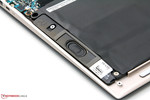
The Ultrabook incorporates two stereo speakers. They are located to the left and right of the palm rest and feature openings (ports) on the bottom. The sound quality is OK, although mids are over-emphasized, while lows and bass are clearly lacking. Overall the sound is decent enough, although we would have expected a bit more from a notebook that features "Audio by Bang & Olufsen ICEpower". Since the speakers have ports on the bottom, the sound depends on the surface the notebook is sitting on. Ideal is a flat, hard surface - like a desk or table. If the Ultrabook is placed on the lap or on a blanket, the sound changes noticeably.
For external audio connections, the user can choose either the 3.5 millimeter audio jack or the Micro HDMI port (via the dongle). The quality is of course dependent on the speaker system used - we tested the connections with a sound system from Teufel and found the sound very pleasing.
Battery Life
Power Consumption
Intel's Ivy Bridge generation of processors are known to offer lower power consumption. Because of the 3D transistors, the CPU exhibits a very good balance between performance and energy efficiency. During office tasks, the notebook consumes between 4.1 and 9.6 Watts. The predecessor consumed up to 11.1 Watts. The minimal power consumption is also much higher for the predecessor UX21E: 6.6 Watts (a plus of 2.5 Watts or 61 percent). Under load, the UX21A is just a little more power-hungry: we measured 34.6 Watts. Considering the hardware and the higher performance, this is perfectly acceptable.
| Off / Standby | |
| Idle | |
| Load |
|
Key:
min: | |
Battery Life
The integrated lithium polymer battery has a capacity of 35 Wh (4800 mAh). Asus used the same type (C23-UX21) in the predecessor. A larger battery either doesn't fit or it would increase the weight of the system too much. The larger Asus Zenbook Prime UX31A features a battery with 50 Wh.
One of the negative aspects of the Asus Zenbook UX21E was the mediocre battery life. The updated version doesn't offer a larger capacity battery, but the hardware is more efficient. When we conducted our WLAN surf-test (wireless on, display brightness 150 cd/m², balanced power profile), the notebook lasted for 4 hours and 14 minutes - 20 minutes longer than the predecessor, but not really a huge improvement. The Apple MacBook Air 11 Mid 2012 has the same capacity battery and lasts much longer in the same test: 5 hours and 44 minutes.
The maximum battery life of the UX21A is 9 hours and 51 minutes (Reader's test with the display brightness at its lowest setting). This is a much more significant improvement: a plus of 199 minutes (34 percent) compared to the predecessor UX21E. The minimum battery life under load (Battery Eater Classic Test) has gotten worse. With the display turned up all the way, performance profile enabled, and all wireless modules on, the notebook only lasted 89 minutes before shutting down.
Verdict
All things considered, the Asus Zenbook Prime UX21A is a successful update of the 11.6-inch UX21E Ultrabook. The new version features an improved keyboard design, a very impressive Full HD display and retained the very high quality chassis - it seems the Apple MacBook Air 11 Mid 2012 (the former leader in this category) has some catching up to do. Performance is up, too - thanks to the Intel Core i7-3517U. The new dual-core CPU allows overclocking to 3.0 GHz and features lower power consumption - especially when performing office-type tasks.
The slim design also has some disadvantages: the port selection is somewhat limited and expandability is restricted. We appreciate the fact that the fan can be cleaned fairly easily. Speaking of the fan: the cooling system remains quite audible under load - although it can easily handle the new hardware. Asus includes a few accessories with the system (MSRP 1199 Euros / ~$1550): two dongles, a sleeve to protect the Ultrabook, and a cleaning cloth. We would love to see the Micro HDMI dongle included - so far this item remains an optional accessory.
The UX21A is an Ultrabook which is quite suitable as a mobile companion. It's about the size of a piece of paper (DIN A4) and weighs 1145 grams (2.52 pounds). We consider it to be a very good alternative to the offering from Cupertino - as long as Mac OS X is not a requirement. The price of almost 1200 Euros (~$1550) seems fair.






